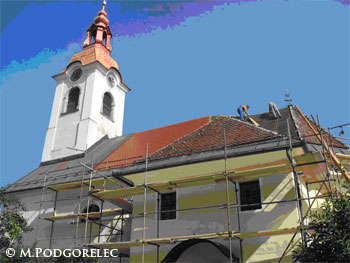 |
|
|
||
THREATS TO AND THE CONSERVATION OF BATS IN SLOVENIA
Up until 2008, 30 species of bats have been recorded in Slovenia, and of these, 28 species have been sighted in recent years (Presetnik et al. 2007). Considering the small size of the country this is a relatively large variety of bat species in comparison to the numbers of species in larger European countries. It is important that people in Slovenia protect and preserve the diversity of bats as they have an important role in maintaining the balance of nature (for example, by regulating the number of insects).
The conservation of bats has, as its main goal, the retention of all bat species. The conservation of bats also means conserving their habitats, such as their roosts (winter roosts, maternity roosts, breeding roosts) and their foraging areas (territories where they are active).
The conservation of bats occurs on a number of levels:
1.) Legislation regarding the conservation of nature, the environment and animals contains regulations which deal with urgent actions, and defines unacceptable actions as well as the criminal consequences of any breach of the regulations.
2.) Legal provisions are, in practice, reenergizing bat conservation and protection.
3.) Informational and educational activities introduce conservation regulations and their scientific (biological) basis to the general public.
1. THREATS AND CONSERVATION
2. CONSERVATION AND LEGISLATION
3. CONSERVATION IN PRACTICE
4. LITERATURE
5. RESEARCH
Although in nature bats have few predators, the population number of some species (lesser horseshoe bat, greater mouse-eared bat) in Europe in the 60s and 70s of the 20th century drastically decreased (Dietz et al. 2007).
The reasons were unclear at the time, but the decline coincided with the introduction of pesticides and the renovation of buildings where they were roosting. Today the bats in Slovenia (Official Gazette of RS, No., 82/02), as also in Europe and in the world (Hutson et al. 2001) are treated as one of the more endangered animal groups, and it is known that bats are most at risk from people interfering with their habitat areas, for instance:
- the destruction of bat roost sites with the renovation of buildings,
- the prevention of access to buildings by meshing entrances,
- the incorrect installation of grates at cave entrances,
- the disturbance of roost sites (e.g. cave tourism),
- the lighting up of flight entrances and exits on buildings containing roost sites, as well as general light pollution,
- the destruction and reduction of forests, or changes in the management of forests (removing old trees with hollows, destroying foraging areas),
- the destruction of key linear elements in the landscape (borders, hedges, isolated trees …),
- the excessive use of pesticides on agricultural land, - the use of wood preservation substances which are poisonous to mammals.
It sometimes happens that people because of fear, prejudice or the mess of bat guano (of excrement) or out of pure malice still:
- intentionally kill or poison bats in the vicinity of their residences.
Bats are also:
- victims of traffic,
- victims of wind power generators.
Due to the above-mentioned negative effects of people on bats and their habitats the protection of these insectivorous animals is especially important.
|
Church renovation |
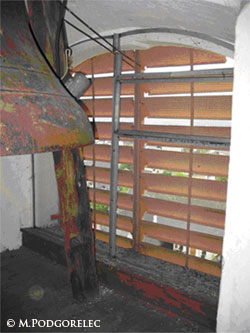 |
Latticed window |
Correctly installed grates to caves |
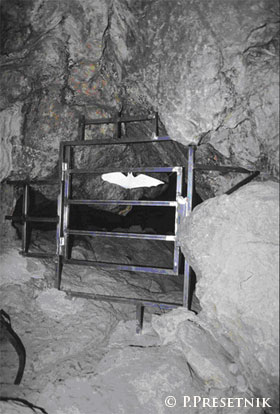 |
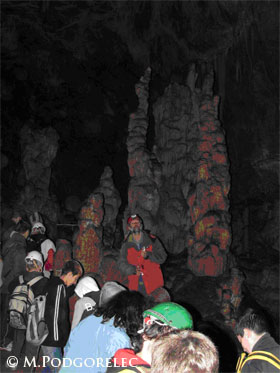 |
Many people in a cave for an event We should not disturb bats in their roost areas. Cave tourism and other cave activities should occur at the times when bats are not wintering there, or in sections which do not contain bats. |
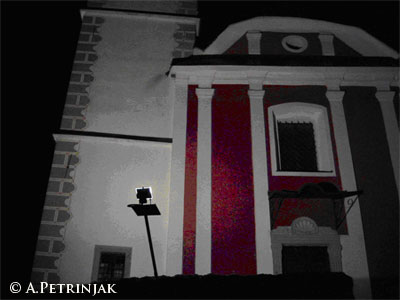 |
Lighting |
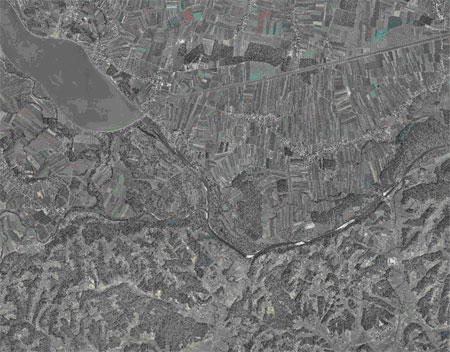 |
Ortofoto photograph of a mosaic landscape and/or of hollows Mosaic landscapes should be preserved with their interwoven areas of: cultivated land, forests, hedges, and mature orchards. In forests, orchards and parks it is necessary to leave trees with hollows as some species shelter in them. |
 Bat hit by a car
|
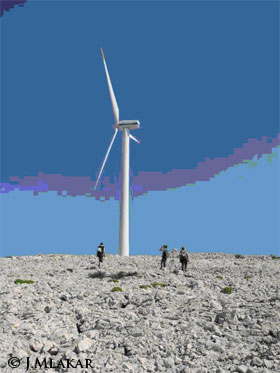 |
Photo beneath the blades of a wind generator
|
Bats in all of Slovenia are legally protected animals, which is why it is necessary to have special permission from the Ministry of the Environment and Spatial Planning under advisement from the Institute of the Republic of Slovenia for Nature Conservation, in order to work with them.
The key items mentioned in the regulations specify that we may not: hurt deliberately, poison, kill, remove from nature, hunt, capture, keep in captivity, disturb or trade in bats. Also, we may not hurt or destroy their habitats (roost sites). Severe sanctions are prescribed for violations.
In practice, the most vital requirement needed for the efficient conservation of bats is the existence of a legal foundation that with laws and other legal instruments regulates and defines the area of the protection and conservation of bats. The following relate to the protection of bats in Slovenia:
1. Slovene legislation with the following acts:
- law on nature conservation (Conservation law - UPB2) (Official Gazette of RS, No., 96/04)
- law on underground cave conservation (ZVPJ) (Official Gazette of RS, No., 2/04)
- law on environmental protection (ZVO - 1) -( Official Gazette of RS, No.,.41/04)
- regulation regarding the placement of endangered plants and animal species on the red list (Official Gazette of RS, No., 82/02)
- regulation regarding ecologically important areas (Official Gazette of RS, No., 48/04)
- regulation regarding specially protected areas (Nature 2000) (Official Gazette of RS, No., 49/04) and changes and supplements to the regulation (Official Gazette of RS, No., 110/04, 59/07, 43/08)
- regulation restricting light pollution (Official Gazette of RS, No., 81/07) and changes and supplements to the regulation (Official Gazette of RS, No., 109/07)
2. European legislation with the following:
- The Council Directive 92/43/EEC on the Conservation of Natural Habitats and of Wild Fauna and Flora - "The Habitat Directive", which lists in supplement II species, for which particular areas are also specified
- Nature 2000 in Slovenia, in supplement IV there are species, that must, out of collective interest, be strictly protected (all Slovene bats).
3. Remaining international legislation within the following acts:
- The Convention on the Conservation of Migratory Species of Wild Animals – CMS (Official Gazette of RS-MP 18/98, correction 27/99; ratified by Slovenia in 1998) especially its: Agreement on the Conservation of Bats in Europe – EUROBATS (Official Gazette of RS -MP, No. 22/03; Slovenia ratified year in 2003).
- The Convention on the Conservation of European Wildlife and Natural Habitats (Official Gazette of RS 55/99, MP No. 17/99; ratified by Slovenia in 1999)
- The Convention on Biological Diversity – CBD (Official Gazette of RS, 30/96, MP No. 7/96; ratified by Slovenia in 1996)
- IUCN Red List of threatened Species (Hutson et al. 2001)
Protective measures for the conservation of bats exist in a number of different areas. Some from these are already performed by different professional bodies in Slovenia (Centre for the Cartography of Fauna and Flora, The Institute of the Republic of Slovenia for Nature Conservation …), our Association also has some experience with some of these.
2.1 Knowledge of the basic status of bats and the regular monitoring of their status
A prerequisite for the successful protection and conservation of bats in Slovenia in practice, is a thorough knowledge of their distribution and, if possible, their numbers and the regular monitoring of their status with research and regular fieldwork. Based on such information we can notice any changes in numbers of a certain species and can choose where conservation measures would be the most logical and efficient. The monitoring of all species of bats in Slovenia is being conducted following the plan and methodology proposed by Presetnik at al. (2007), the Centre for the Cartography of Fauna and Flora is in charge of monitoring the status of bats.
2.2 General protection of the foraging areas and other habitats of bats and of important landscape elements
It is necessary to preserve, for example, large and unbroken areas of forest cover, old trees with hollows, large cultivates meadows, mature orchards with tall tree trunks, hedges … and to abandon the large-scale use of pesticides.
2.3 Conservation of roost sites
It is necessary to protect all important wintering areas consistently (caves, mines, castle cellars), maternity roosts in the roof spaces of buildings and in old tree hollows, mating sites and transitional roosts, to ban the meshing and lighting up of flight openings and to ensure that consultancy takes place regarding the renovation of buildings …
Examples: Ajdovšcina Cave, Brestanica, Rihemberk
2.4 Establishment of potential new roost sites
For example, with free access to uninhabited roof spaces, creating crevice roosts on the facades and roofs of houses, with the installation of bat boxes in forests, on buildings …
Example: Installing bat boxes next to the Ljubljanica River
2.5 Reducing accident risks
When planning infrastructure, especially large roads and wind power generators it is necessary to avoid: important bat habitats, the area around the vicinity of roost sites with larger clusters of bats …
2.6 Care of sick or injured bats
The care of sick or injured bats does not directly contribute to the existing population of bats, but is an important part of spreading information about the conservation of bats to the general public.
2.7 Educating and informing the general public
We cannot protect what we do not know and value. That is why it is so important to spread information about bats and their endangered status among all age groups. In this way, for example, we can increase the likelihood of the timely notification about the presence of bats in buildings and of planned renovations.
Denac, K., 2003. Mortaliteta vretenčarjev na cestah Ljubljanskega barja : diplomskanaloga : univerzitetni študij = Road mortality of vertebrates on Ljubljansko barje (Slovenia): graduation thesis : university studies. Ljubljana: [K. Denac], X, 62 f., ilustr., graf. prikazi, pril.
Dietz, C., O. von Helversen & D. Nill, 2007. Die Fledermäuse Europas und Nordwestafrikas. Biologie, Kennzeichen, Gefährdung. Kosmos Verlag, Stuttgart. 399 str.
Hlad, B. & P. Skoberne (ured.), 2001. Pregled stanja biotske raznovrstnosti in krajinske pestrosti v Sloveniji, Agencija RS za okolje, Ministrstvo za okolje in prostor, Ljubljana, 224 str.
Hutson, A.M., S.P. Mickleburgh & P.A. Racey (Ed.), 2001. Microchiropteran bats: global status survey and conservation action plan. IUCN/SSC Chiroptera Specialist Group. IUCN, Gland, Switzerland and Cambridge, UK. 258 str.
Kryštufek, B., P. Presetnik & A. šalamun, 2003. Strokovne osnove za vzpostavljanje omrežja Natura 2000: Netopirji (Chiroptera) (končno poročilo). Naročnik: MOPE, ARSO, Ljubljana. Prirodoslovni muzej Slovenije, Ljubljana. 322 str., digitalne priloge. (http://www.ckff.si/dokumenti/netopirji.pdf )
Presetnik, P., 2001. Varstvo netopirjev na gradu Grad na Goričkem (Predhodno poročilo o spremljanju sezonske dinamike vrst in števila netopirjev (marec 2000 - marec 2001) ter priporočila za varstvo netopirjev. Ljubljana. 36 str.
Presetnik, P., 2003. Strokovni naravovarstveni nadzor nad obnovitvenimi deli na gradu Grad na Goričkem. Naročnik: Ministrstvo za okolje, prostor in energijo, Ljubljana. Center za kartografijo favne in flore, Miklavž na Dravskem polju. 24 str.
Presetnik, P., 2004. Monitoring stanja populacij netopirjev na gradu Rihemberk s poskusom zagotovitve zatočišča (poročilo). Naročnik: MOPE, Ljubljana. Center za kartografijo favne in flore, Miklavž na Dravskem polju. 37 str.
Presetnik, P., 2004. Monitoring stanja populacij netopirjev v Ajdovski jami (poročilo). Naročnik: MOPE, Ljubljana. Center za kartografijo favne in flore, Miklavž na Dravskem polju. 30 str.
Presetnik, P., M. Podgorelec, V. Grobelnik & A. šalamun, 2007. Monitoring populacij izbranih ciljnih vrst netopirjev (Zaključno poročilo). Naročnik: MOP, Ljubljana. Center za kartografijo favne in flore, Miklavž na Dravskem polju. 251 str.
Rodrigues, L., L. Bach, M.-J. Dubourg-Savage, J. Goodwin & C. Harbusch, 2008. Guidelines for consideration of bats in wind farm projects. EUROBATS Publication Series No. 3 (English version). UNEP/EUROBATS Secretariat, Bonn, Germany, 51 pp.
Zagmajster, M., K. Koselj, N. Zupancic, A. Petrinjak & K. Jazbec, 2006. Bat conservation in Slovenia. In: Jones, M., O. Classen & D. Krueger (Eds.), 1991-2006 EUROBATS celebrates its 15th anniversary, str. 94-100, EUROBATS Publication Series No. 1. UNEP/EUROBATS Secretariat, Bonn, Germany
… and other literature
Prepared by: Monika Podgorelec
The text on conservation on this webpage was prepared within the framework of the project “Do not disturb, sleeping bats” funded by the Government Communication Office of the Republic of Slovenia in cooperation with the Ministry of the Environment and Spatial Planning.

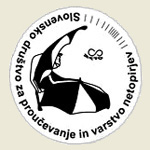 |
 |
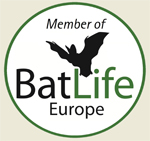 |
 |
